2009 CHEVROLET HHR parking brake
[x] Cancel search: parking brakePage 402 of 450
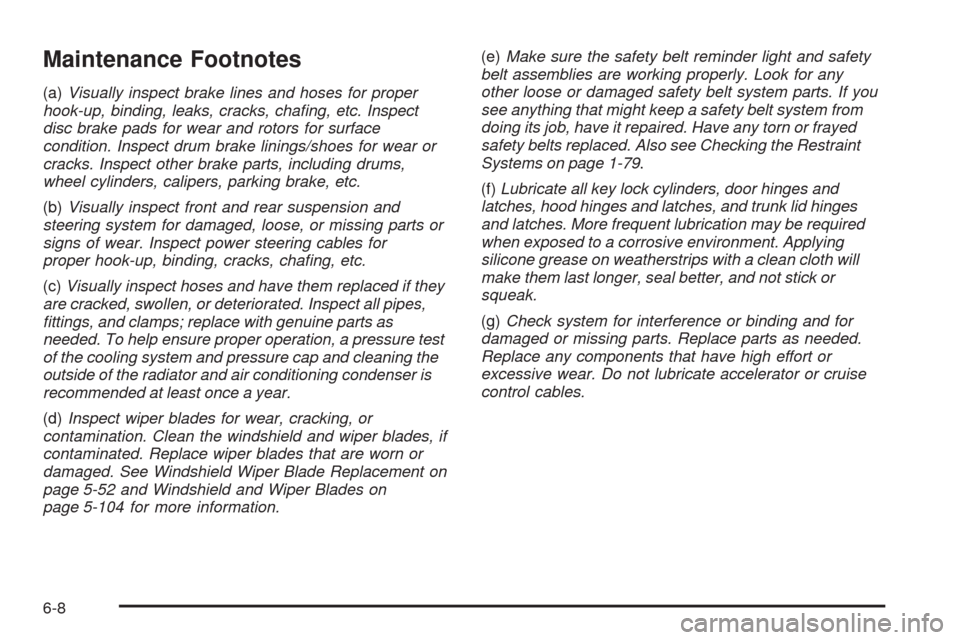
Maintenance Footnotes
(a)Visually inspect brake lines and hoses for proper
hook-up, binding, leaks, cracks, chafing, etc. Inspect
disc brake pads for wear and rotors for surface
condition. Inspect drum brake linings/shoes for wear or
cracks. Inspect other brake parts, including drums,
wheel cylinders, calipers, parking brake, etc.
(b)Visually inspect front and rear suspension and
steering system for damaged, loose, or missing parts or
signs of wear. Inspect power steering cables for
proper hook-up, binding, cracks, chafing, etc.
(c)Visually inspect hoses and have them replaced if they
are cracked, swollen, or deteriorated. Inspect all pipes,
fittings, and clamps; replace with genuine parts as
needed. To help ensure proper operation, a pressure test
of the cooling system and pressure cap and cleaning the
outside of the radiator and air conditioning condenser is
recommended at least once a year.
(d)Inspect wiper blades for wear, cracking, or
contamination. Clean the windshield and wiper blades, if
contaminated. Replace wiper blades that are worn or
damaged. See Windshield Wiper Blade Replacement on
page 5-52 and Windshield and Wiper Blades on
page 5-104 for more information.(e)Make sure the safety belt reminder light and safety
belt assemblies are working properly. Look for any
other loose or damaged safety belt system parts. If you
see anything that might keep a safety belt system from
doing its job, have it repaired. Have any torn or frayed
safety belts replaced. Also see Checking the Restraint
Systems on page 1-79.
(f)Lubricate all key lock cylinders, door hinges and
latches, hood hinges and latches, and trunk lid hinges
and latches. More frequent lubrication may be required
when exposed to a corrosive environment. Applying
silicone grease on weatherstrips with a clean cloth will
make them last longer, seal better, and not stick or
squeak.
(g)Check system for interference or binding and for
damaged or missing parts. Replace parts as needed.
Replace any components that have high effort or
excessive wear. Do not lubricate accelerator or cruise
control cables.
6-8
Page 405 of 450
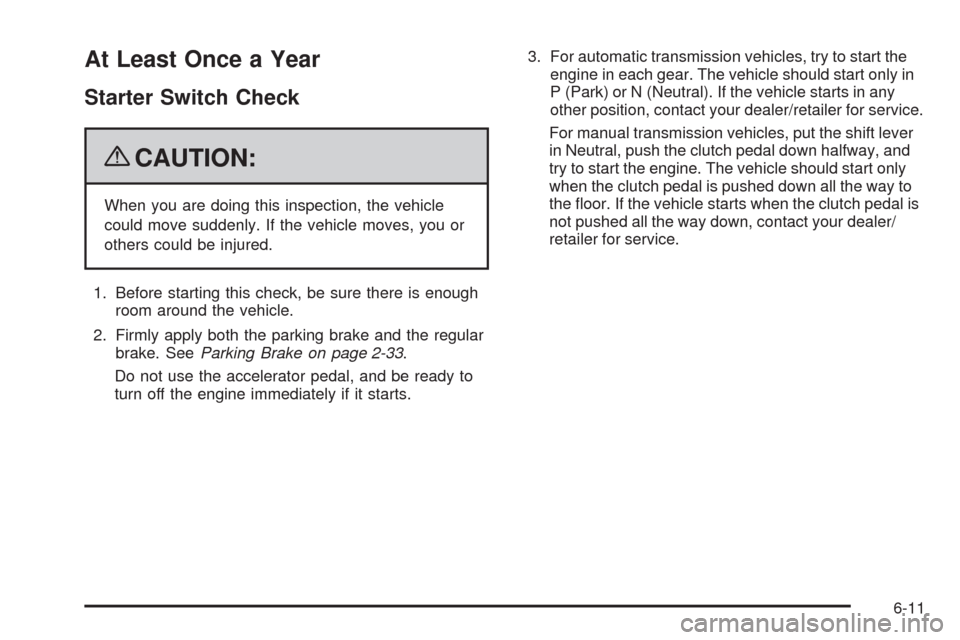
At Least Once a Year
Starter Switch Check
{CAUTION:
When you are doing this inspection, the vehicle
could move suddenly. If the vehicle moves, you or
others could be injured.
1. Before starting this check, be sure there is enough
room around the vehicle.
2. Firmly apply both the parking brake and the regular
brake. SeeParking Brake on page 2-33.
Do not use the accelerator pedal, and be ready to
turn off the engine immediately if it starts.3. For automatic transmission vehicles, try to start the
engine in each gear. The vehicle should start only in
P (Park) or N (Neutral). If the vehicle starts in any
other position, contact your dealer/retailer for service.
For manual transmission vehicles, put the shift lever
in Neutral, push the clutch pedal down halfway, and
try to start the engine. The vehicle should start only
when the clutch pedal is pushed down all the way to
the �oor. If the vehicle starts when the clutch pedal is
not pushed all the way down, contact your dealer/
retailer for service.
6-11
Page 406 of 450
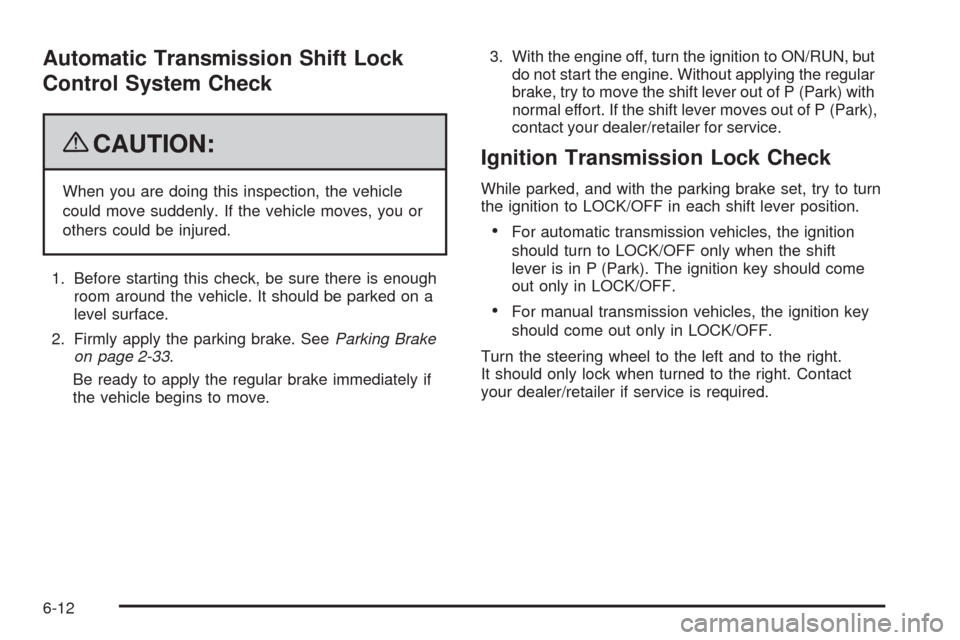
Automatic Transmission Shift Lock
Control System Check
{CAUTION:
When you are doing this inspection, the vehicle
could move suddenly. If the vehicle moves, you or
others could be injured.
1. Before starting this check, be sure there is enough
room around the vehicle. It should be parked on a
level surface.
2. Firmly apply the parking brake. SeeParking Brake
on page 2-33.
Be ready to apply the regular brake immediately if
the vehicle begins to move.3. With the engine off, turn the ignition to ON/RUN, but
do not start the engine. Without applying the regular
brake, try to move the shift lever out of P (Park) with
normal effort. If the shift lever moves out of P (Park),
contact your dealer/retailer for service.
Ignition Transmission Lock Check
While parked, and with the parking brake set, try to turn
the ignition to LOCK/OFF in each shift lever position.
For automatic transmission vehicles, the ignition
should turn to LOCK/OFF only when the shift
lever is in P (Park). The ignition key should come
out only in LOCK/OFF.
For manual transmission vehicles, the ignition key
should come out only in LOCK/OFF.
Turn the steering wheel to the left and to the right.
It should only lock when turned to the right. Contact
your dealer/retailer if service is required.
6-12
Page 407 of 450
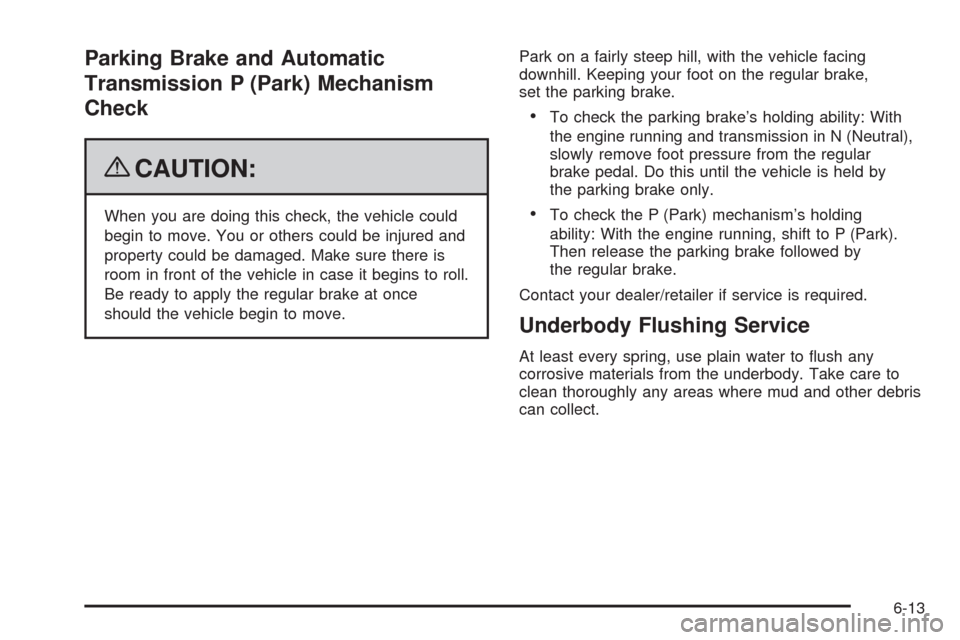
Parking Brake and Automatic
Transmission P (Park) Mechanism
Check
{CAUTION:
When you are doing this check, the vehicle could
begin to move. You or others could be injured and
property could be damaged. Make sure there is
room in front of the vehicle in case it begins to roll.
Be ready to apply the regular brake at once
should the vehicle begin to move.Park on a fairly steep hill, with the vehicle facing
downhill. Keeping your foot on the regular brake,
set the parking brake.
To check the parking brake’s holding ability: With
the engine running and transmission in N (Neutral),
slowly remove foot pressure from the regular
brake pedal. Do this until the vehicle is held by
the parking brake only.
To check the P (Park) mechanism’s holding
ability: With the engine running, shift to P (Park).
Then release the parking brake followed by
the regular brake.
Contact your dealer/retailer if service is required.
Underbody Flushing Service
At least every spring, use plain water to �ush any
corrosive materials from the underbody. Take care to
clean thoroughly any areas where mud and other debris
can collect.
6-13
Page 408 of 450
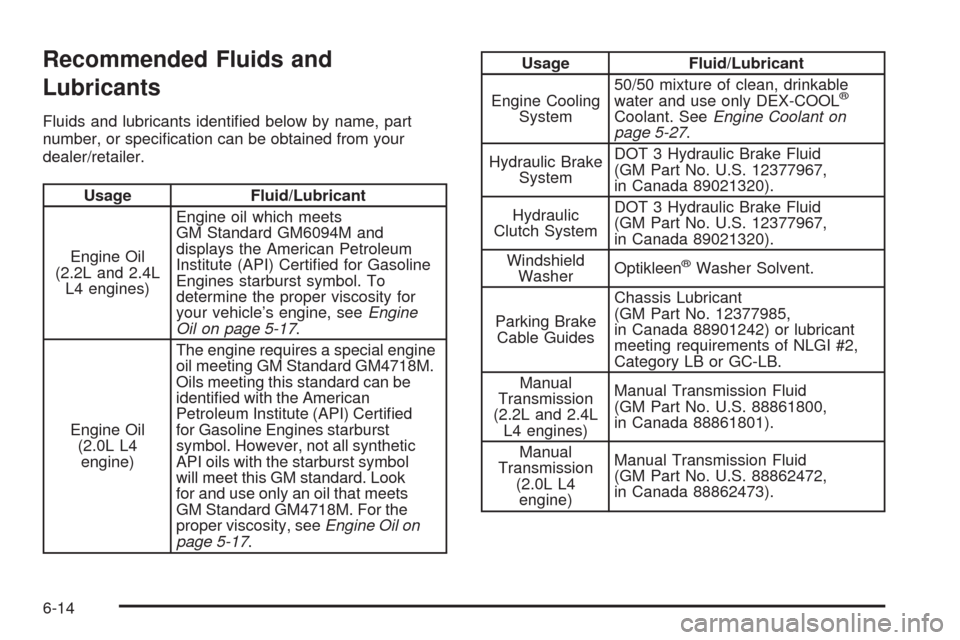
Recommended Fluids and
Lubricants
Fluids and lubricants identi�ed below by name, part
number, or speci�cation can be obtained from your
dealer/retailer.
Usage Fluid/Lubricant
Engine Oil
(2.2L and 2.4L
L4 engines)Engine oil which meets
GM Standard GM6094M and
displays the American Petroleum
Institute (API) Certi�ed for Gasoline
Engines starburst symbol. To
determine the proper viscosity for
your vehicle’s engine, seeEngine
Oil on page 5-17.
Engine Oil
(2.0L L4
engine)The engine requires a special engine
oil meeting GM Standard GM4718M.
Oils meeting this standard can be
identi�ed with the American
Petroleum Institute (API) Certi�ed
for Gasoline Engines starburst
symbol. However, not all synthetic
API oils with the starburst symbol
will meet this GM standard. Look
for and use only an oil that meets
GM Standard GM4718M. For the
proper viscosity, seeEngine Oil on
page 5-17.
Usage Fluid/Lubricant
Engine Cooling
System50/50 mixture of clean, drinkable
water and use only DEX-COOL
®
Coolant. SeeEngine Coolant on
page 5-27.
Hydraulic Brake
SystemDOT 3 Hydraulic Brake Fluid
(GM Part No. U.S. 12377967,
in Canada 89021320).
Hydraulic
Clutch SystemDOT 3 Hydraulic Brake Fluid
(GM Part No. U.S. 12377967,
in Canada 89021320).
Windshield
WasherOptikleen
®Washer Solvent.
Parking Brake
Cable GuidesChassis Lubricant
(GM Part No. 12377985,
in Canada 88901242) or lubricant
meeting requirements of NLGI #2,
Category LB or GC-LB.
Manual
Transmission
(2.2L and 2.4L
L4 engines)Manual Transmission Fluid
(GM Part No. U.S. 88861800,
in Canada 88861801).
Manual
Transmission
(2.0L L4
engine)Manual Transmission Fluid
(GM Part No. U.S. 88862472,
in Canada 88862473).
6-14
Page 436 of 450
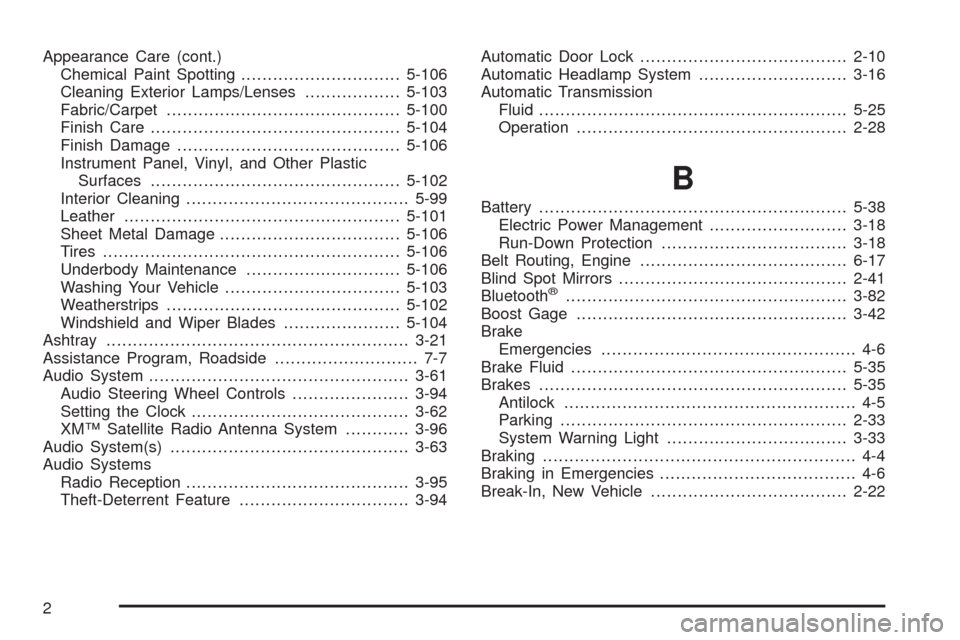
Appearance Care (cont.)
Chemical Paint Spotting..............................5-106
Cleaning Exterior Lamps/Lenses..................5-103
Fabric/Carpet............................................5-100
Finish Care...............................................5-104
Finish Damage..........................................5-106
Instrument Panel, Vinyl, and Other Plastic
Surfaces...............................................5-102
Interior Cleaning..........................................5-99
Leather....................................................5-101
Sheet Metal Damage..................................5-106
Tires........................................................5-106
Underbody Maintenance.............................5-106
Washing Your Vehicle.................................5-103
Weatherstrips............................................5-102
Windshield and Wiper Blades......................5-104
Ashtray.........................................................3-21
Assistance Program, Roadside........................... 7-7
Audio System.................................................3-61
Audio Steering Wheel Controls......................3-94
Setting the Clock.........................................3-62
XM™ Satellite Radio Antenna System............3-96
Audio System(s).............................................3-63
Audio Systems
Radio Reception..........................................3-95
Theft-Deterrent Feature................................3-94Automatic Door Lock.......................................2-10
Automatic Headlamp System............................3-16
Automatic Transmission
Fluid..........................................................5-25
Operation...................................................2-28
B
Battery..........................................................5-38
Electric Power Management..........................3-18
Run-Down Protection...................................3-18
Belt Routing, Engine.......................................6-17
Blind Spot Mirrors...........................................2-41
Bluetooth
®.....................................................3-82
Boost Gage...................................................3-42
Brake
Emergencies................................................ 4-6
Brake Fluid....................................................5-35
Brakes..........................................................5-35
Antilock....................................................... 4-5
Parking......................................................2-33
System Warning Light..................................3-33
Braking........................................................... 4-4
Braking in Emergencies..................................... 4-6
Break-In, New Vehicle.....................................2-22
2
Page 445 of 450
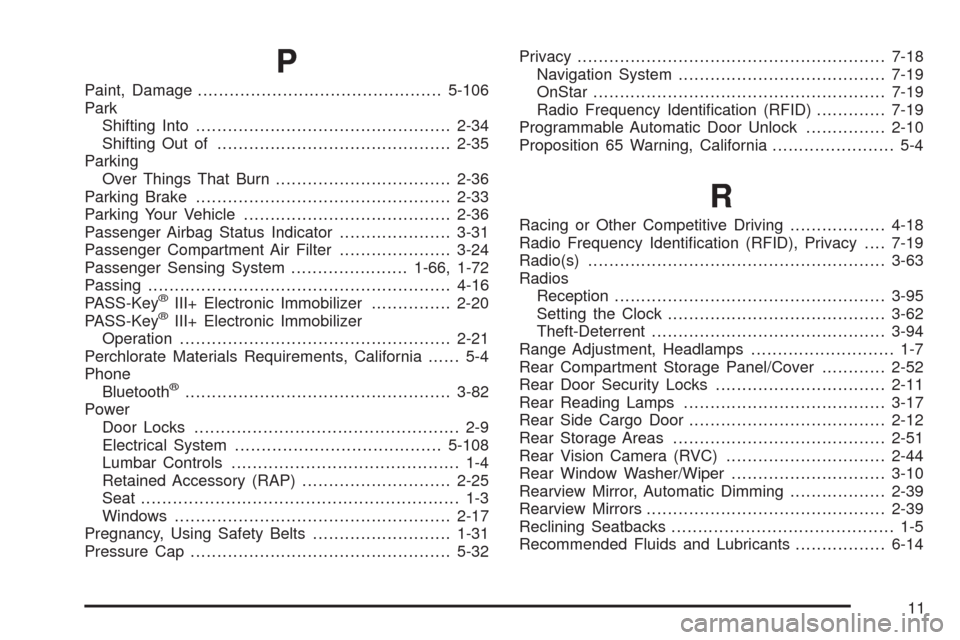
P
Paint, Damage..............................................5-106
Park
Shifting Into................................................2-34
Shifting Out of............................................2-35
Parking
Over Things That Burn.................................2-36
Parking Brake................................................2-33
Parking Your Vehicle.......................................2-36
Passenger Airbag Status Indicator.....................3-31
Passenger Compartment Air Filter.....................3-24
Passenger Sensing System......................1-66, 1-72
Passing.........................................................4-16
PASS-Key
®III+ Electronic Immobilizer...............2-20
PASS-Key®III+ Electronic Immobilizer
Operation...................................................2-21
Perchlorate Materials Requirements, California...... 5-4
Phone
Bluetooth
®..................................................3-82
Power
Door Locks.................................................. 2-9
Electrical System.......................................5-108
Lumbar Controls........................................... 1-4
Retained Accessory (RAP)............................2-25
Seat ............................................................ 1-3
Windows....................................................2-17
Pregnancy, Using Safety Belts..........................1-31
Pressure Cap.................................................5-32Privacy..........................................................7-18
Navigation System.......................................7-19
OnStar.......................................................7-19
Radio Frequency Identi�cation (RFID).............7-19
Programmable Automatic Door Unlock...............2-10
Proposition 65 Warning, California....................... 5-4
R
Racing or Other Competitive Driving..................4-18
Radio Frequency Identi�cation (RFID), Privacy....7-19
Radio(s)........................................................3-63
Radios
Reception...................................................3-95
Setting the Clock.........................................3-62
Theft-Deterrent............................................3-94
Range Adjustment, Headlamps........................... 1-7
Rear Compartment Storage Panel/Cover............2-52
Rear Door Security Locks................................2-11
Rear Reading Lamps......................................3-17
Rear Side Cargo Door.....................................2-12
Rear Storage Areas........................................2-51
Rear Vision Camera (RVC)..............................2-44
Rear Window Washer/Wiper.............................3-10
Rearview Mirror, Automatic Dimming..................2-39
Rearview Mirrors.............................................2-39
Reclining Seatbacks.......................................... 1-5
Recommended Fluids and Lubricants.................6-14
11